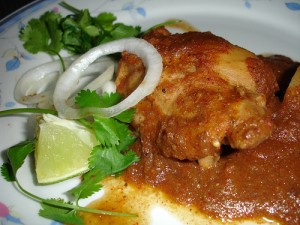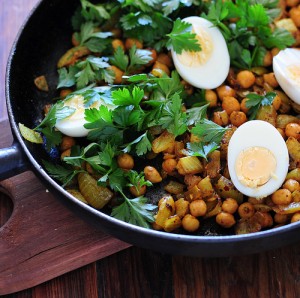I love a good curry, which can be problematic on the low oxalate diet. If you check out the top four ingredients in most commercial curry powders, you will find three are high oxalate (turmeric, cumin, and coriander) and one hasn’t been tested (fenugreek seeds). No wonder the only commercially-available curry powder that’s been tested is really high oxalate (72 mg. oxalate per tablespoon for McCormick’s brand curry powder. And most curry recipes call for 2 – 3 tablespoons. Yikes!).
If you’ve been missing curry, take heart. Here’s a run down of traditional curry spices, herbs, flavorings and oils by oxalate content, so you can start experimenting again today!
Curry Spices by Oxalate Content:
High Oxalate Medium Oxalate Low Oxalate Very Low Oxalate
Turmeric* Cardemom Yellow Mustard Garlic
Cumin Seed Nutmeg Raw Ginger Lemon Juice
Coriander Lemon Peel Fresh Green Chilis Lemon extract**
Cinnamon* Paprika Fresh Cilantro Cinnamon extract**
Clove* Black Pepper Fresh Basil Chrystallized Ginger (ground)
Fennel Seed* Cayenne Pepper Sage** Curcumin Supplements**
Ground Ginger Fresh Jalapeno** White Pepper Coconut milk, oil or flesh
Anise Seed Fresh Serrano** Fresh Cayenne Tobasco Sauce**
Not Tested: Fenugreek Seed, Curry Leaves, Asafoetida, Tamarind
Serving size for all dried herbs and spices is 1 teaspoon. Serving sizes for fresh ingredients vary, but are “reasonable” serving sizes such as two tablespoons chopped green chilies, 2 jalapeno peppers, 6 small cayenne peppers, or 1 clove garlic.
*Above 25 mg. oxalate per serving (very high oxalate)
**Not traditional, but can be used to replace some traditional ingredients with yummy results
Making Low Oxalate Curry: As you can see, not all is lost! If you want to make your own low oxalate curry powder or low oxalate curries, you have plenty of medium, low and very low oxalate spices, herbs and flavorings to choose from. I strongly suggest you don’t use any of the very high oxalate spices (those marked with one asterick), especially turmeric (which is really high oxalate). Although most people associate curry with turmeric, it has very little taste and is used in curries mainly for the health properties of its most biologically-active component—curcumin. Curcumin is a strong anti-inflammatory and antioxidant, and may be added to your curries by breaking open a few low oxalate curcumin capsules. Curcumin supplements will also add the traditional yellow color to your final dish and helps preserve the traditional health benefits of eating curry. I strongly recommend adding curcumin capsules to your curry, especially since oxalate causes oxidative stress and inflammation–two conditions helped by curcumin. Some very painful inflammatory conditions can be improved with curcumin supplementation, plus some very positive results have been seen in the autism community.
Although you probably shouldn’t use the very high oxalate ingredients in your curries, I do make an exception for cumin and occasionally for coriander. Cumin and coriander are very strong-tasting traditional Indian spices, and a little bit can go a long way. Try using small amounts of cumin or coriander in your curry (about ¼ to ½ teaspoon); just don’t go crazy with it. Also, remember spices and dried herbs lose their flavor fast in your cabinet (see Five Tips for Using Herbs and Spices). Make sure your herbs and spices are as fresh as possible—less than a month old if you can–especially if you are going to use high oxalate spices like cumin in your recipes. You want as much flavor for the oxalate as possible.
Low Oxalate Curry Powders:If you’re ready to start experimenting with low oxalate curries, you will love the two low oxalate curry powders below. Karla over at the Trying Low Oxalates Yahoo Group is a fabulous and creative chef who keeps a database of low oxalate recipes in the group’s applications area (click here for the data base if you are already a member of this fabulous group. If you are not a member, see Top Ten Reasons to Join the Trying Low Oxalates Yahoo Group and join today!). Karla has shared many yummy curry recipes in the low oxalate recipe database (20 at last count), most of which include her signature low oxalate curry powder. This is a mild curry powder that can be used in any recipe that calls for curry powder; just don’t substitute it tablespoon for tablespoon! To keep things low oxalate, try using one teaspoon of Karla’s low oxalate curry powder for each tablespoon of regular curry powder in your favorite curry recipe (and be sure to significantly reduce or eliminate any other high oxalate curry seasoning!).
Karla’s Low Oxalate Curry Powder
1/2 tsp ground ginger
1 tsp cardamom
4 tsp granulated garlic
2 tsp chilli powder
1 tsp ground sage
1 tsp lemon/orange zest
1 tsp ground cumin
3 Enhansa 150 mg capsules
1 1/2 tsp salt
1 tsp white pepper
Combine all of the ingredients and store in an airtight container (open the curcumin capsules and add the powder to your mix). Makes 15 teaspoons.
Note: If you don’t have Enhansa, 1 Jarrow Curcumin 95 capsule can also be used.
Low Oxalate Info: If you check out this recipe in the Trying Low Oxalates recipe database, you’ll notice that Karla always puts the oxalate content of each ingredient in parenthesis next to the ingredient. I removed these here for editorial reasons, but this is another bonus of using the recipe database in the trying Low Oxalates Yahoo Group. You always know exactly where your oxalate is coming from! Karla’s low oxalate curry powder has about 6.7 mg oxalate per teaspoon. If you want to reduce the oxalate content of this fabulous curry powder even further, I suggest you leave out the lemon or orange zest and add a few drops (up to a ½ teaspoon) of pure lemon extract or pure orange extract to your recipe (add it to a liquid ingredient if possible and mix well). Lemon extract and orange extract are very low oxalate, and leaving the zest out of Karla’s powder reduces the oxalate content to about 5.1 mg. per teaspoon.
Low Oxalate Curry Powder with Mustard:
If you enjoy curry with mustard, you’ll love this low oxalate curry powder with ground yellow mustard, especially when combined with cauliflower, chicken or fish. I didn’t add any ginger, cilantro or basil to my powder because I prefer to add these ingredients fresh (plus, I almost always add more fresh garlic). I might also occasionally add fresh chilies or hot peppers to a curry if I want more heat, but generally a teaspoon or two of my low oxalate curry powder with mustard provides enough heat for me. Again, to keep things low oxalate, use 1 teaspoon of low oxalate mustard curry powder for 1 tablespoon of regular curry powder in your favorite recipes and ditch or significantly reduce any other high oxalate seasonings.
Low Oxalate Curry Powder with Mustard
1 teaspoon cumin
1 teaspoon cardamom
2 teaspoons ground yellow mustard
1 teaspoon cayenne pepper
1 teaspoon sage
1 teaspoon white pepper
3 Enhansa 150 mg. capsules or 1 Jarrow Curcumin 95 capsule
2 teaspoons granulated garlic
Combine all of the ingredients and store in an air-tight container for up to two months (open the curcumin capsules and add them to your mix). Makes about 11 teaspoons (recipe halves easily if you don’t think you’ll use this powder quickly enough–use two Enhansa capsules or one Jarrow 95 capsule if you halve the recipe).
Low Oxalate Info: Low Oxalate Mustard Curry Powder has about 4.1 mg. oxalate per teaspoon.
Photo credits go to jules:stone soup for Boiled Eggs with Curried Chickpeas, rovingl for Kheema, Poha and Chicken Curry.




{ 11 comments… read them below or add one }